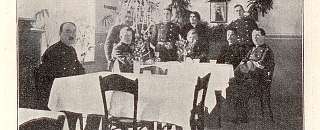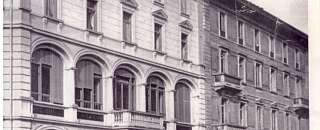History
In 1913 a few members of the local Reformed Protestant church noted that Lugano lacked an alcohol-free restaurant something they considered as a necessity given the social problems of the time such as unemployment, alcoholism and family disputes. Pastor Niklaus Bolt, a famous Swiss writer, had been studying the idea of opening an alcohol-free restaurant for a long time, especially since the parish hall no longer had enough space.
To realize the project, a sum of CHF 10,000 was needed. The funds came from donations from friends of the association “defenders of the cause” and the proceeds of a Ticino themed evening held in Basel.
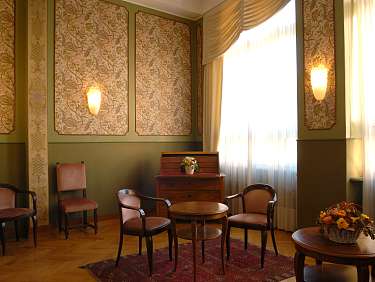
1914
In February 1914, the “Verein für alkoholfreies Restaurant” (association for alcohol-free restaurants) was founded and in March 1914, appropriate premises at Corso Pestalozzi 13, property of Emilio Lucchini, were located.
The name of the restaurant "Pestalozzihof" stems from the location at Corso Pestalozzi. The premises consisted of two communal halls and a restaurant. One of the main principles was that the restaurant should not pursue any political or religious objectives, and another was the strict ban, for the employees, on accepting tips.
In June 1914, the doors of the alcohol-free restaurant Pestalozzihof opened. The initial period was very tedious and particularly hindered by the lack of foreign guests and the increase in food prices due to the World War I. Despite all these difficulties, the results of the first year of activity showed a profit of CHF 314.42.
Initially, the management was entrusted to private persons, however after a third replacement in less than two years, the restaurant was run by a corporate counsel together with the board of directors of the association.
The restaurant soon became a popular meeting place for soldiers thanks to the close cooperation with the "Committee for the Care of Soldiers in Switzerland". It was also valued as a peaceful spot for those who wished to read or to write.
In 1918, in order to ensure the continuation of the activity, interventions of the Ufficio degli approvvigionamenti (Procurement Bureau) in Bellinzona were needed - especially to guarantee delivery of provisions in sufficient quantities and at affordable prices. Notwithstanding all these difficulties, the turnover amounted to CHF 40’000 with an average of 110 clients per day. In 1919, the number was already 60,000.
To arouse the interest of the local population, which was still very skeptical with regard to an alcohol-free restaurant (an improvement was noticed only in 1925), bazaars, theater nights and conferences on various topics were organized.
The economic situation worsened in 1921 and in 1922, many young people lost their jobs and had to relocate. In 1923, following numerous requests, a few members suggested the possibility of transforming Pestalozzihof into a hospice.
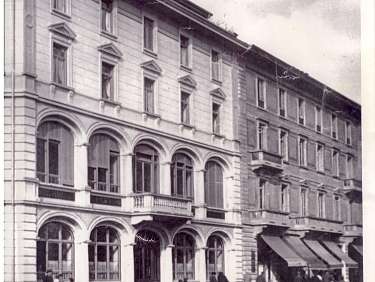
1924 - 1927
In 1924, a proposal to purchase the premises was submitted to Mr. Lucchini however he refused to sell. In May 1926, the Pestalozzihof began, for the first time, to rent rooms in Mr. Lucchini’s property. The number of customers of the restaurant rose to 85,000 per year.
In 1927, the association received an offer from Mr. Beretta to purchase the current property for CHF 126,000. After an initial refusal and only after a thorough inspection together with architect Heidemann (who had also built the Spa Center in Cademario), it was decided to purchase the property situated on Piazza Indipendenza.
The project was financed with bonds of the Banca della Svizzera Italiana, donations and fundraising. The corner stone was laid in December 1927. The project included 38 rooms with 70 beds, a restaurant on the ground floor sitting 160 and two communal halls on the 1st floor.
In 1927, the restaurant across the street, which continued to operate, attained a frequency of 123,000 customers per year.
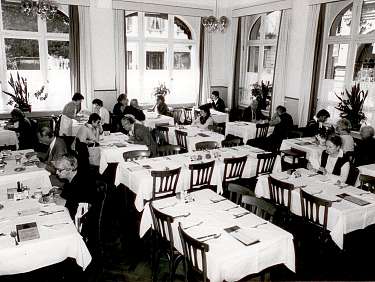
1928
In November 1928, the Pestalozzihof was officially opened with rooms and communal halls ready to welcome guests.
The total cost amounted to CHF 535,000. In the final settlement - due to the lack of liquidity - craftsmen were also paid with bonds, which were however repurchased within a few years.
In the thirties and forties, management of the business encountered a series of obstacles among which the problematic economic context and World War II: the blackout ban, the constant lack of staff called home or into the military, the rationing of food, linen and coal, the ban on fried dishes due to the shortage of oil and fat, the mandatory no-meat days, lack of coffee, eggs and cheese, and the consequent difficulty in creating a daily menu for the restaurant. Despite all these difficulties, the number of patrons increased year after year.
The daily menu was mainly based on Swiss German cuisine with a large selection of homemade cakes and sweets. Towards the end of the forties, special emphasis was placed on vegetarian cuisine.
At the end of the forties, renovation of the rooms commenced and machines which facilitated manual labor, were acquired. Similarly, cold and hot water was installed in the rooms. In 1947, the restaurant registered 170'485 customers and there were 17'577 overnight guests.
Between 1950 and 1960, the kitchen was renovated, the restaurant refurbished, an oil heater installed, and the hotel was expanded by the conversion of the loft into rooms. 1962 registered 213'630 customers at the restaurant, which corresponds to a daily average of 585 guests a number that is hard to imagine today.
This positive trend was interrupted in 1967 when the first self-service restaurants were opened by Innovazione, Epa and Cooperativa Migros, which caused an immediate loss of 50,000 customers in one year.
In 1974, due to the room shortage, the south wing of the fourth floor was amplified: another 6 rooms were constructed, and the current lift was installed. Further renovations were urgent, however the steep bank rates and the low earnings of the restaurant and the hotel had not allowed the association to accumulate reserves. To increase earning, prices were gradually increased, and the hotel was renovated in stages from 1979 to 1987. A total of CHF 2'500'000 was spent on these investments, which was financed by own funds and a mortgage of only CHF 222'000. In the eighties, the rooms and subsequently the halls on the first floor, the restaurant with buffet, and finally the courtyard, the kitchen and the main entrance were renovated.
Since 1997 investment in the hotel has been continuous and a total of CHF 14'000'000 has been spent, 80% of which was financed by own funds. From the beginning in 1914, the cooperative has been able to count on individuals who have devoted themselves, voluntarily and with great commitment and enthusiasm, to the management of this public enterprise. Despite two world wars, financial problems and difficulties finding staff, they have never been discouraged and have always believed that the running analcohol-free business was a good cause.
Initially the restaurant, then the hotel was run, for years, by mademoiselles “Fräulein” who came, mainly, from the German-speaking part of Switzerland and who had experience in the management of alcohol-free businesses. Miss Sieber was in the corporate counsel from 1918 to 1975 - over 55 years. These women ran the business under strict conditions and were employed at the Pestalozzihof, in average, for 20-40 years. The "austerity" concerned above all the strict alcohol-free requirement and rooms were checked to avoid guests or employees consuming alcoholic beverages or drugs.
In 2014, we celebrated our 100th year of activity. In 2015, the alcohol ban was lifted and since then, guests can taste our excellent Ticino wines.
As in the past, we are very, very pleased to be able to count on extremely loyal personnel who have been working with us for more than 20 years; we take this opportunity to heartfully thank them for their great dedication and support of our cooperative.
Since 1998 the hotel is managed by Manuela & Luciano Fadani-Eidenberger. Luciano Fadani is responsible for the restaurant, and every day creates a varied menu, with - adapted to the season - Swiss, Ticino, Italian and vegetarian specialties and homemade pasta dishes. With his ironic nature and amicable personality, he welcomes our guests and makes them feel at home. They appreciate being able to escape, for a few hours, the daily stress and problems and enjoy discussing football, travel, fashion and technology.
Today the Hotel Pestalozzi Lugano presents itself with:
- 54 rooms with 93 beds
- A-la-carte restaurant with 124 seats
- Conference room "Saal Pestalozzi" on the 1st floor with 150 seats Pestalozzi
- 2 small conference rooms with 20 seats each
- Small gym with 1 treadmill and 1 exercise bike
Last renovation: October 2022 to April 2023 - complete renovation of 17 rooms on 3 floors in the north wing. All rooms in the SUPERIOR and MODERN categories have been newly furnished and equipped with air conditioning.
